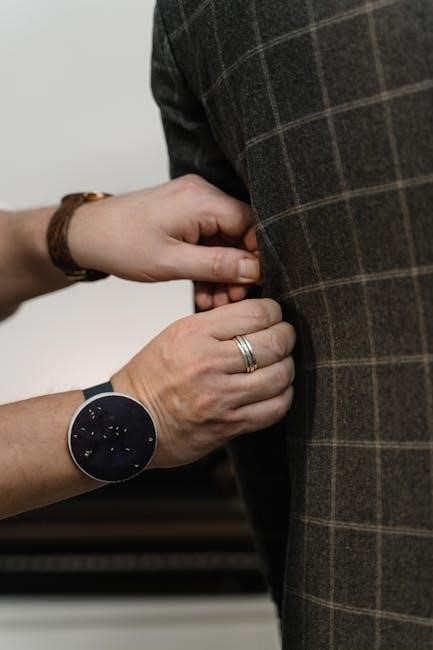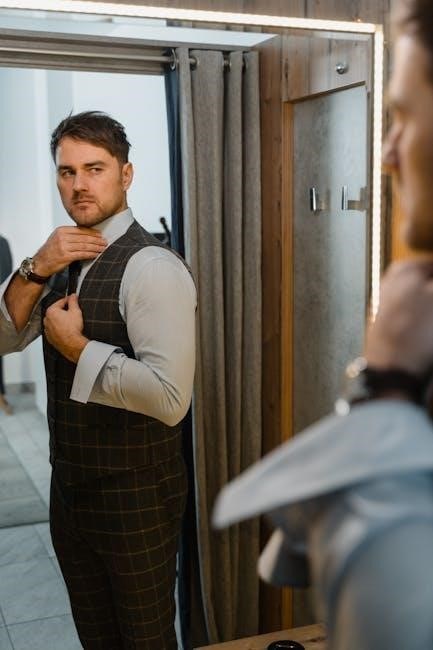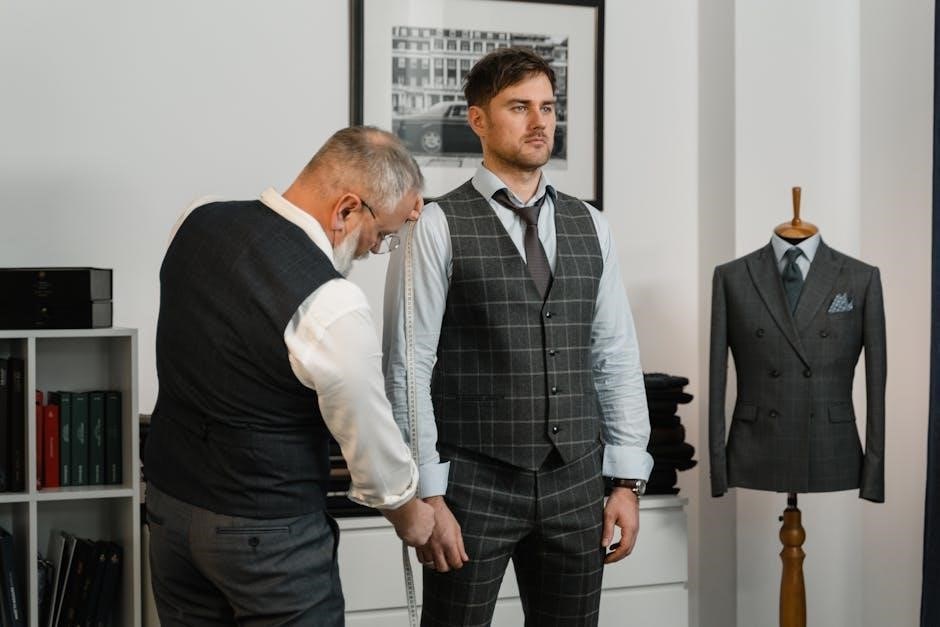
suit jacket measurement guide
A well-fitted suit jacket enhances confidence and style. This guide provides a comprehensive overview of key measurements and tips to ensure a perfect fit, covering chest, shoulders, and length.
1.1 Importance of Proper Fit in a Suit Jacket
A proper fit in a suit jacket is essential for both style and confidence. It ensures the jacket drapes naturally, accentuating your physique without restricting movement. A well-fitted jacket creates a balanced, polished appearance, making it appropriate for formal and professional settings. Ill-fitting jackets can look unflattering, drawing attention away from your overall look. Proper fit also enhances comfort, allowing you to move freely while maintaining a sharp, put-together aesthetic. Whether you’re attending a wedding, a business meeting, or a special event, a suit jacket that fits perfectly elevates your presence. Understanding the importance of proper fit is the first step to selecting or tailoring a jacket that complements your body type and personal style.
1.2 Key Measurements for a Perfect Suit Jacket Fit
The foundation of a well-fitted suit jacket lies in accurate measurements. The chest measurement is crucial, as it determines the jacket’s width and ensures a comfortable fit around the torso. Shoulder measurements are equally important, as they ensure the jacket sits naturally without puckering or sagging. Sleeve length is another critical factor, striking a balance between functionality and aesthetics. Jacket length should proportions to your height and body type, while the waist measurement allows for a defined silhouette. These key measurements work together to create a tailored fit, whether you’re selecting off-the-rack or opting for custom-made. Mastering these measurements is essential for choosing the right size and making informed alterations.

How to Measure Yourself for a Suit Jacket
Measuring yourself accurately ensures a perfect fit. Use a flexible tape measure, stand upright, and follow specific steps for chest, shoulders, sleeve length, and waist to get precise measurements.
2.1 Chest Measurement: The Foundation of Jacket Sizing
The chest measurement is crucial for determining your suit jacket size. To measure accurately, wrap a flexible tape measure around the broadest part of your chest, keeping the tape level and parallel to the floor. Ensure the tape isn’t too tight or too loose—it should feel comfortable. This measurement will typically be the primary factor in selecting your jacket size. For example, a 40-inch chest usually corresponds to a size 40 jacket. Remember to take this measurement while wearing a lightweight, fitted shirt to ensure accuracy. This foundational measurement sets the stage for a well-fitted jacket that complements your physique.
2.2 Shoulder Measurement: Ensuring a Natural Fit
The shoulder measurement is the second most critical factor after the chest when determining a suit jacket’s fit. To measure your shoulders accurately, stand upright and place the tape measure across the back, starting from the tip of one shoulder and ending at the tip of the other. This measurement ensures the jacket’s shoulder pads align naturally with your body. A well-fitted jacket should neither be too tight, restricting movement, nor too loose, appearing ill-fitting. The shoulder measurement helps maintain the jacket’s structure and balance. For example, if your shoulders are broader, you may need a larger size to accommodate the fit comfortably. Proper shoulder alignment ensures a sharp, tailored appearance.
2.3 Sleeve Length Measurement: Finding the Ideal Balance
Sleeve length is a critical factor in achieving a polished look. To measure accurately, start at the center back of your neck, extend the tape over your shoulder, and down to your wrist. The ideal sleeve length allows a quarter to half an inch of shirt cuff to show, creating a balanced appearance. Sleeves that are too long can overwhelm the jacket, while too-short sleeves disrupt the proportion. Proper sleeve length ensures comfort and style, allowing ease of movement while maintaining a tailored fit. This measurement is essential for both off-the-rack and custom jackets, ensuring the sleeves complement your body proportions and jacket style.
2.4 Jacket Length Measurement: Determining the Perfect Cut
Jacket length is essential for a balanced and flattering fit. To measure correctly, place the tape at the base of the neck, running it down the spine to the desired jacket length. For most men, the ideal length reaches just below the hip or the top of the thigh, ensuring the jacket complements the body proportions. Jacket length varies based on style and body type, with shorter jackets suited for petite builds and longer styles for taller individuals. Proper length ensures the jacket sits naturally, creating a streamlined silhouette. This measurement is crucial for achieving a polished, tailored look, whether for a slim-fit or classic cut.
2.5 Waist Measurement: Tailoring for a Defined Silhouette
The waist measurement is crucial for achieving a tailored fit, ensuring the jacket complements your body’s natural contours. To measure, stand upright and wrap the tape around the narrowest part of your torso, just above the hipbone. Ensure the tape is level and not too tight. This measurement helps determine how much the jacket will taper at the sides, creating a defined silhouette. For slim-fit jackets, a narrower waist measurement is preferred, while regular fits allow more room. Tailors use this measurement to adjust darts and seams, ensuring the jacket sits smoothly without appearing boxy. Accurate waist measurement is vital for a polished, custom-fit look that enhances your overall appearance.

Understanding Suit Jacket Size Charts
Suit jacket size charts vary by brand, offering standard, slim, and tailored fits. They typically combine chest size with shoulder measurements to determine the best fit for your frame.
3.1 Standard Size Charts: Decoding Numbers and Letters
Standard size charts use a combination of numbers and letters to denote fit. The number typically represents chest size, while letters indicate fit style, such as S, M, or L.
3.2 Slim Fit vs. Regular Fit: What’s the Difference?
Slim Fit and Regular Fit are two distinct styles in suit jackets, catering to different body types and preferences. Slim Fit jackets are tailored closer to the body, creating a modern, streamlined appearance. They feature narrower cuts through the chest, shoulders, and sleeves, making them ideal for slimmer builds. Regular Fit jackets, on the other hand, offer a looser, more relaxed silhouette, providing comfort and a classic look. They are designed with a bit more room in the chest and shoulders, making them suitable for broader or more muscular frames. Understanding these differences helps in selecting the most flattering fit for your body type and personal style.
Choosing the Right Jacket Fit for Your Body Type
Selecting the right jacket fit involves understanding your body proportions and personal style. Proper measurements ensure comfort, confidence, and a polished appearance, tailored to your unique physique.
4.1 Factors Influencing Jacket Size Selection
Several factors determine the ideal jacket size, including body type, height, and personal style preferences. Chest and shoulder measurements are critical, as they form the foundation of a tailored fit. Additionally, torso length, arm proportions, and desired comfort level play significant roles. For instance, taller individuals may opt for longer jackets, while shorter builds benefit from shorter styles. Regular, slim, or tailored fits cater to different body types, ensuring both comfort and aesthetics. Understanding these elements helps in selecting a jacket that aligns with individual needs, ensuring a flattering and comfortable fit. Proper sizing enhances both appearance and confidence.
4.2 Determining Your Body Type for a Flattering Fit
Identifying your body type is crucial for selecting a suit jacket that flatters your physique. Common categories include slim, athletic, average, and larger builds. Slim individuals benefit from tailored fits to avoid excess fabric, while athletic builds may opt for structured shoulders for balance. Average body types can choose classic styles, ensuring a proportional fit. Larger builds should look for jackets with a defined waist to create a streamlined appearance. Understanding your body type allows for informed style choices, ensuring the jacket complements your natural shape. Proper fit enhances both comfort and aesthetics, making it essential to consider body type when selecting a suit jacket.
Tailoring and Alterations
Tailoring ensures a precise fit, addressing areas like sleeve length, shoulder alignment, and waist definition; Professional alterations enhance comfort and aesthetics, making the jacket truly personalized.
5.1 The Role of Tailoring in Achieving the Perfect Fit
Tailoring plays a crucial role in ensuring a suit jacket fits flawlessly. Even with accurate measurements, off-the-rack jackets may not perfectly align with individual body types. Professional tailors can adjust details such as shoulder alignment, sleeve length, and waist definition to create a customized fit. This process not only enhances comfort but also elevates the jacket’s aesthetic appeal. Tailoring allows for personalization, making the jacket look and feel like it was made specifically for the wearer. By addressing minor discrepancies, tailors can transform a standard suit into a bespoke piece, ensuring every aspect complements the wearer’s physique.
5.2 Common Alterations for a Customized Jacket
Common alterations for a customized jacket include sleeve length adjustments, shoulder padding tweaks, and waist tapering to enhance fit. Jacket length can be shortened or extended for proportionality. Shoulder adjustments ensure natural alignment, while sleeve cuffs may be narrowed or widened for comfort. Buttonholes and vents are often tailored for a personalized touch. These modifications ensure the jacket meets individual preferences, blending style and functionality. Tailors may also reshape the collar or adjust the chest drape for a sleeker appearance. Such alterations transform an off-the-rack piece into a bespoke garment, offering a perfect balance of comfort and aesthetics.
A well-fitted suit jacket is key to confidence and style. This guide provides essential tips on measurements and alterations. Invest in tailoring for a perfect fit and style.

6.1 Final Tips for a Well-Fitted Suit Jacket

Ensuring a perfect fit requires attention to detail. Always opt for a tailored alteration to adjust sizing precisely. Button the jacket to check if it lies flat without strain. Posture matters—stand naturally during fittings. Pair the jacket with matching pants or a vest for a cohesive look. Fabric choice impacts comfort and style, so select wisely. Remember, a well-fitted jacket boosts confidence and completes your outfit. Invest time in measurements and alterations for a sharp, polished appearance.